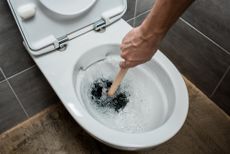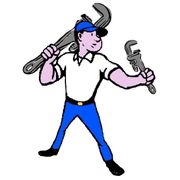5 Tips for Preventing a Clogged Basement Drain

Basement floor drains help to draw away excess water and prevent flooding. Usually set at the lowest point of your house, they’re an efficient, necessary tool. However, just like any drain, they can get clogged. Below are five tips for preventing a backup or flood, and ultimately needing a drain cleaning.
How to Avoid a Clogs in Your Basement’s Drain
1. Avoid Grease & Fats
Never pour fats, oils, and grease down your drain. They harden as they cool, and leave behind a thick goo that will trap debris, such as discarded food and grime. The buildup will narrow or block the path for water to flow through and cause flooding in your basement. Instead, dispose of grease and fats in a container, then throw them away in the trash.
2. Monitor Soap Usage
Avoid excess detergent when washing clothes. Too much soap, particularly powder-based detergents, can interfere with water drainage. Since both soap particles and scum don’t dissolve completely, they accumulate and create a blockage in drains and pipes. The residue attaches to the inner walls of your plumbing, resulting in backups, and water overflows in the basement soon after.
3. Watch What’s Flushed
 Make sure only human waste and toilet paper are flushed down your drains. Avoid sending paper towels, tissues, sanitary napkins, dental floss, and flushable wipes—which some expect to work like toilet paper. These items don’t break down entirely and leave behind accumulated debris. Only flush toilet paper and waste, and you’ll have less flooding and drain cleanings.
Make sure only human waste and toilet paper are flushed down your drains. Avoid sending paper towels, tissues, sanitary napkins, dental floss, and flushable wipes—which some expect to work like toilet paper. These items don’t break down entirely and leave behind accumulated debris. Only flush toilet paper and waste, and you’ll have less flooding and drain cleanings.
4. Install a Gate
Backflow preventer gates or backwater valves are designed to stop a backup before it becomes a moldy, pungent problem in your basement. When sensors detect flooding backflow, the gate immediately shuts, cutting off flow from the sewer system and preventing a flood. The gate ensures that the water only flows in one direction, forcing wastewater away from your home and back into the sewer system. If the system fails or the clog continues to cause the gate to engage, call a plumber to resolve the issue.
Additionally, a backflow valve prevents several future issues. For example, it stops rain from entering via the pipes and blocks flooding from back-flowing into the basement or plumbing. Finally, because the city can send water back through the sewer, a valve is necessary to prevent flooding.
5. Remove Hair
Hair can wad up and tangle in drains, and, since it doesn’t break down, collect gunk and debris that leads to clogs over time. Drain screens can stop hair from going down. However, if you don’t install one, stay on top of clearing hair out of the drains in sinks, tubs, and other fixtures.
If your basement drain is backing up in the Twin Cities area, call Do It Right Plumbing Sewer & Drain Services. Located in Eagan, MN, their professional drain cleaning ensures your home is no longer in danger of floods caused by clogs. Their licensed plumbers are also well-versed in sewer cleaning and basic repairs like clogged toilets and installations. For emergency plumbing, call (612) 388-8524. Visit their website for a full list of services.
About the Business
(2 reviews)
Have a question? Ask the experts!
Send your question

